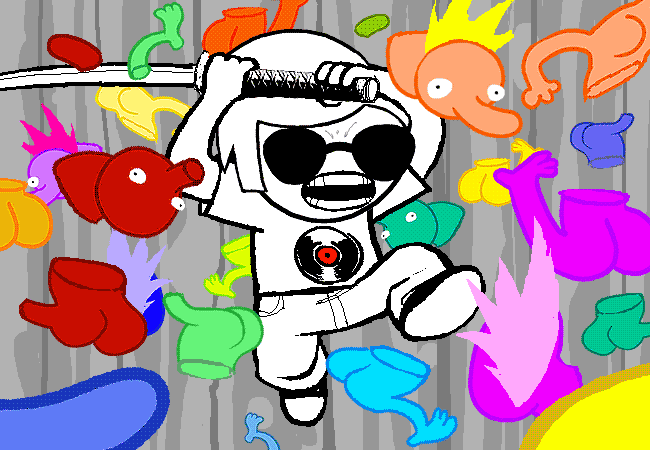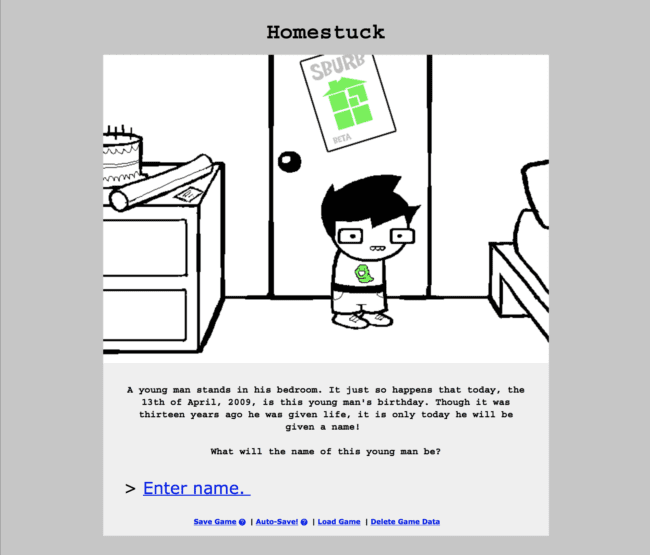I remember the manic hype around Homestuck during its original run online (between 2009 and 2016), which easily consumed the attention on anyone within five or six degrees of it. The oversaturated presence of the webcomic and its rabid fans exhausted me before I even had a chance to want to read it on my own terms. On top of that, it was overwhelming to even think of diving into if you weren't already on the wagon during the first year, and I had missed that cut-off point. The jagged pixel artwork, the torrential updates, and the copious walls of colorful chat conversations were turn-offs for me, and the buzz about it was deafening. The webcomic became a magnetic field that you were either completely absorbed by or fully repelled by. No in-betweens, no casual readers. This sort of fandom environment was the quintessence of the decade. The early 2000s felt to me like everyone was completely in thrall to their particular media fandom (RIP SuperWhoLock) and then something happened in the early 2010s and the open manic enthusiasm started to fade out. Avid fandoms are still around of course, but I think the proliferation of social justice discourse began heavily permeating online social media at this point and readers became more careful as to what and, more importantly, who they wanted to stan for publicly. This is all to say that the virtual participatory fan culture around Homestuck, its generation, and consistent fervent popularity has been my only point of engagement until now, an interesting but distant vantage point.
Now to the brick of a book at hand. Homestuck, Book 1: Acts 1 & 2 is an interesting but overall redundant artifact. Homestuck follows a small group of tweens as they chat online, avoid their guardians, and watch their homes get destroyed by meteors before getting sucked into a video game. In his preface, Hussie is quick to point out that most of the first three acts were influenced by reader submissions and that the virtual locus of Homestuck is crucial; seeing it in static book form means readers miss out on the dynamism its digital nature provides. These books are meant to be supplementary at best. As someone reading it for the first time in book form, this made me less than excited to read further.
My first hurdle was everything the art and format immediately signaled. Videogames! The last (and probably only) point-and-click adventure game I remember playing was back in '98 and it was called Freddi Fish 3: The Case of the Stolen Conch Shell. I don't remember a lot about it except the dogfish was called Old Soggy. Anyway, I knew immediately Homestuck was going to be out of my experiential jurisdiction. There was references being made and I wasn't going to get them. I didn't start playing video games until my early teens and even then only a triple A game here or there. I have no nostalgia for the creative foundation this story builds upon. In the commentary at the bottom of each page, Hussie explains his intent on including game constructs and game logic and teaches both the character and the reader how to use them. He also reassures the reader that all is purposeful and will eventually coalesce into a complex meaningful narrative, despite these first few acts relying on his readership's submitted actions. I usually wouldn't want creator commentary to be a part of my initial impression on a first read-through, but there was so much extensive referencing to games, computer science, and his own previous work that it felt impossible not to do the homework.

Isolating my thoughts on the art itself: it's... homely. It's not completely hideous, not Sweet Bro and Hella Jeff grotesquerie. It's obvious he has knowledge of form, depth, and color. The minimal techniques at play still never hit a solid cohesiveness. The visual gag of having copy-pasted Googled objects and art inserted within the panels works for me (slightly), but overall it's not reaching the kitsch aesthetic bar it needs to be interesting. Instead, it comes off as haphazard, a collection of technical shortcuts. There's a lack of gravitas to the visuals, even the animated money shots that pull back to reveal large elaborate environments. Lack of detail is the tradeoff you make when you churn work out too fast, and Hussie was working at breakneck speeds. I still wish there was more finesse and time taken with these images and their armless stamped-on figures. I found the scenes with Wayward Vagabond in the golden desert and approaching a frog temple well-drawn and more compositionally balanced than the art in the rest of the book. I also liked the brief panels where we get more expressive closeups of the children’s faces, drawn with a careful tapered line. That care and visual liveliness is missing in a lot of this book. Regardless of its imperfections, I feel like it's obviously achieving what it means to be on multiple levels: a look that's more reminiscent of video game walkthrough screenshots than comics, layered clunky, garish interfaces, and tacky neon text. It's artistic simplicity and the visual shortcuts it takes also feels endearing, like the messiness of it is helping maintain the integrity of Hussie's narrative goal. He's outracing his inner editor, going for a thematic clarity that only speed can give him over obsessing over precise aesthetics or obsessing over choices. The spontaneity of the story and the telling of it, committing to creative choices and building off them no matter how ridiculous, feed each other like an ouroboros.

Hussie's storytelling in these first two acts is chaotic and comical but often tiresomely repetitive, despite the fervor he plainly has for the project. While most of his gags pay off, he often chases down jokes and beats them until well after they're dead. The focus on game logic gags, data structures, and endless digressions gets tedious after a while even when they deliver on their punchlines. It's humorous dead air. The plot itself is excitingly convoluted, with Hussie laying the groundwork for virtual realities, alien dimensions, shared paradoxes, and time travel, but it would have benefited from some jokes being left on the cutting-room floor. Hussie's writing for his four tween internet friends has to be my favorite aspect of this series so far. The characters all have unique ways of speaking which he nails in every conversation and emphasizes in their chat styles with nerdy quirks. It is entertainingly and sincerely evocative of what it's like growing up socially isolated IRL and spending a majority of your time on the internet in the early 2000s. I remember the agonizing wait for my friends to come online and respond to messages I sent from our chat the night before, the intimate, awkward conversations and the playful off-color jokes that neither of us knew pushed a boundary but accepted without question anyway.
The choice of formatting for this book is another small but ugly problem. The web version of Homestuck has you click through single panel to single panel the majority of the time. In print we most often get a standard four-panel page, some single panel pages, and some pages that are chat text only. The issue arises with the more exhaustively animated scenes or minigames, where keyframes, which can number up to twelve at a time, are compressed and then clustered into a single page, some awkwardly aligned on the page, unnecessarily disjointed. Even panels that are given room on a four-panel page still suffer from detail loss because of compression and it had me squinting to see the minor but important details. All in all this was a mediocre way to experience a comic I'm actually interested in continuing to read. The dedication to the aesthetic, its liminal position between mediums and the unique superimposition of his character's loci of control is fascinating. Even with the wry bonus commentary from Hussie, this variant form of Homestuck is lackluster in comparison to its jittering, melodic virtual original and doesn't adequately translate this robust iconic webcomic to paper.









